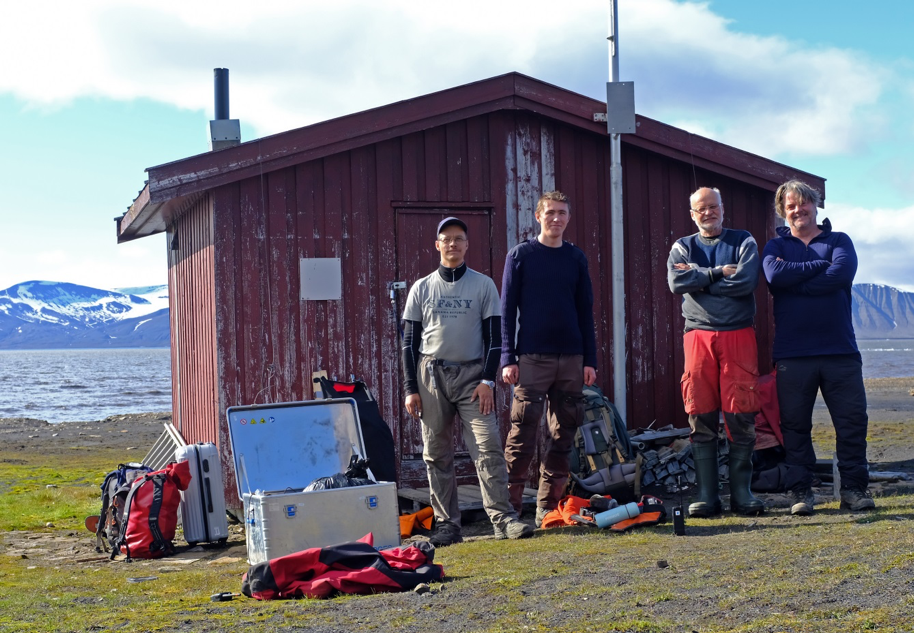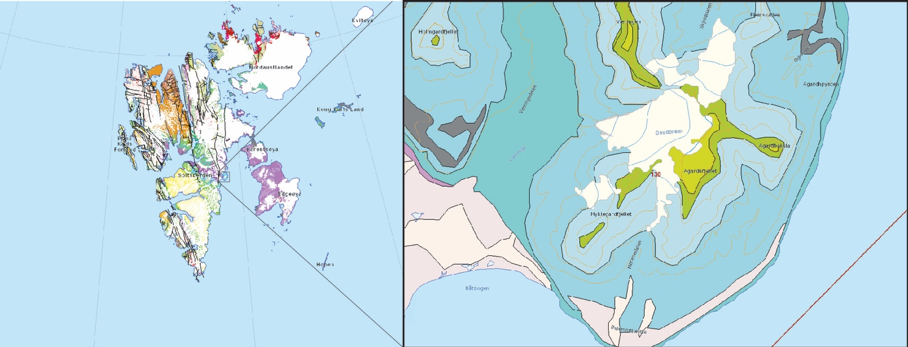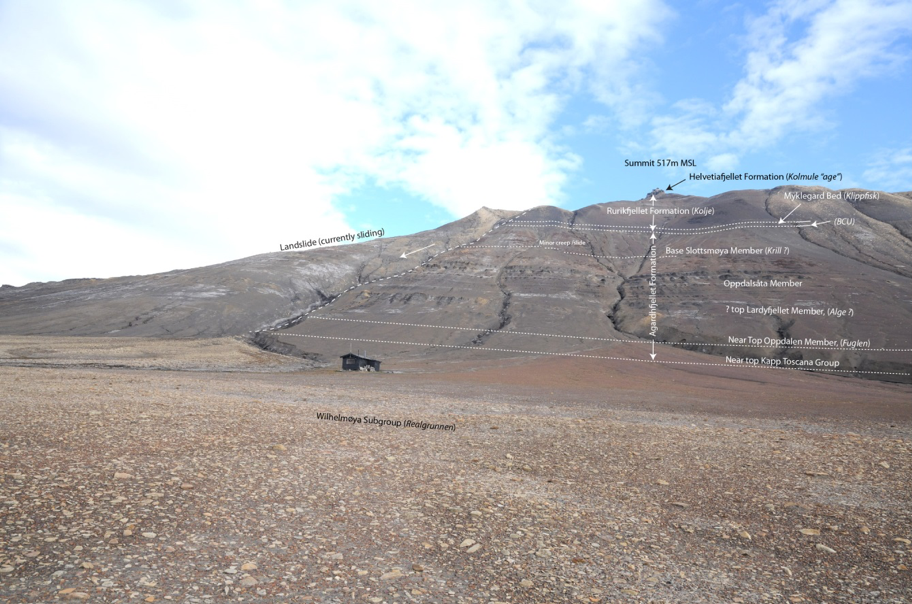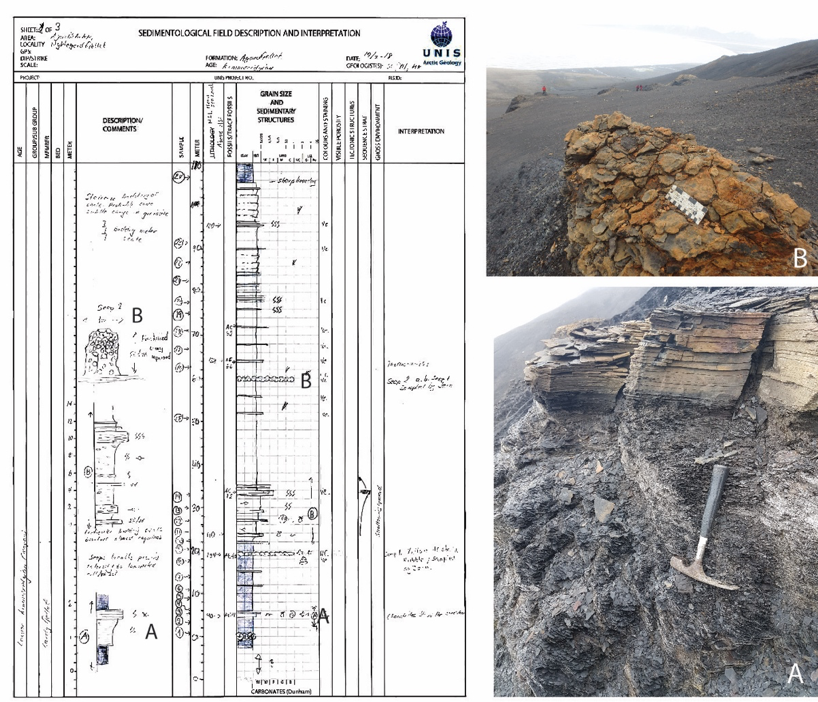The Middle Jurassic to Lower Cretaceous succession in the Agardhbukta, east coast of Spitsbergen, was studied during mid July this summer by a multidisciplinary team of geoscientists (Figure 1).

Figure 1: Men in Black (rocks) in front of Villa Agardhbukta waiting for transport back to Longyearbyen. As always when leaving outcrops, the sun will suddenly appear. From left: Dr Mikhail Rogov (Russian Academy of Science, Moscow) specialized in ammonites and Arctic Jurassic stratigraphy. Master student Erik Schytt Holmlund (UNIS and University of Stockholm). Professor Snorre Olaussen (UNIS) specialized in sedimentology. Professor Jørn Hurum (University of Oslo), a vertebrate palaeontologist and hydrocarbon seeps expert.
Field work
The purpose of the field work was to construct a sedimentary log, collect macrofossils, and sample for palynology and rock eval analysis in a low maturity and less tectonically disturbed area than western Spitsbergen. The outcome will hopefully improve our understanding of the facies by improving biostratigraphic and sequence stratigraphic resolution of the succession and the hydrocarbon potential (maturity, HI, TOC, i.e.) of organic rich units. Finally, the sequence stratigraphic subdivision within the archipelago will be constrained and further correlated to the offshore analogues in the greater Barents Sea, and possibly Kara, Laptev seas, East Greenland, and Sverdrup Basin.
Myklgardfjellet, Agardhbukta
The outcrop in Myklgardfjellet, Agardhbukta (Figure 2 and 3) has some stratigraphic challenges due to landslides, creeping between the active layer in the permafrost (Figure 3) and possibly, although not observed, some distal influence from West Spitsbergen Fold and Thrust Belt. A 250 m thick, continuous succession of the Middle Jurassic to Lower Cretaceous Agardhfjellet Formation was logged, analogue to the offshore Fuglen and Hekkingen Formations. Numerous ammonites were collected and one large shoulder-limb with preserved attachments for fingers was dug up. Initial inspection suggests that it probably belonged to an Ichthyosaurus (c.f. Hurum et al. 2016). Hydrocarbon-bearing carbonates with paraffinic odour (figure 4) were sampled. Hydrocarbon-bearing rocks were previously known from Central Spitsbergen and from upper part of the succession in Myklegardfjellet. Presumably, hydrocarbon seeps in carbonate rocks are much more common in the Agardhfjellet Formation than previously reported (and offshore in the Barents Sea?).

Figure 2: Geological map of Svalbard, with insert from Agardhbukta north. Greenish; Barremian Helvetia and Carolinefjellet formations. Light Blue; Rurikfjellet Formation. Blue; Agardhfjellet Formation. Turquoise; Kapp Toscana Group.

Figure 3: Stratigraphy of the logged succession of the Myklegardfjellet, with offshore linked units. The offshore Hekkingen equivalent, which includes Lardyfjellet, Oppdalsåta and Slottsmøya members, is approximate 200m thick in this area.
The logged succession also shows a much more distal facies than west Spitsbergen (Koevoets et al. 2018). However, an enigmatic 30cm thick, ellipsoid/lenticular shaped, burrowed, medium-grained clean sandstone with sharp, erosive, lower boundary and rich ichnofauna was found at the top of the succession. Preliminary, it is interpreted to represent a gutter cast, suggesting that the coast was not far away in the transition between the Kimmeridgian and Volgian.

Figure 4: Field log of the lower section (110 meter). (A) shows a 2m coarsening upward (CU) units; black organic rich paper shale is passing upward to dark grey silty shale with burrows. The CU unit is capped by laminated silty fine grained sandstone with combined wave current ripples. Similarly, CU units are common in this formation throughout Svalbard and also observed in the Hekkingen Formation in southwestern Barents Sea. They represent either distal part of a prograding clastic wedge, i.e. part of a para sequence or as a result climate variations e.g. increased storm activity. (B) shows hydrocarbon stained carbonates. Similar seeps higher up in the section indicate migration from Upper Jurassic Source i.e. the host rock (Abay et al. 2017).
Reference
Hurum, J.H., Nakrem, H.A., Hammer, Ø, Knutsen, E. M., Druckenmiller, P.S., Hryniewicz, K. & Novis, L.K. 2012. An Arctic Lagerstätte – the Slottsmøya Member of the Agardhfjellet Formation (Upper Jurassic – Lower Cretaceous) of Spitsbergen. Norwegian Journal of Geology, Vol 92, pp. 55-64.
Koevoets, M.J., Hammer, O., Olaussen, S., Senger, K. & Smelror, M. 2018: Integrating subsurface and outcrop data of the Middle Jurassic to Lower Cretaceous Agardhfjellet Formation in central Spitsbergen. Norwegian Journal of Geology 98, 1–34. https://dx.doi.org/10.17850/njg98-4-01


